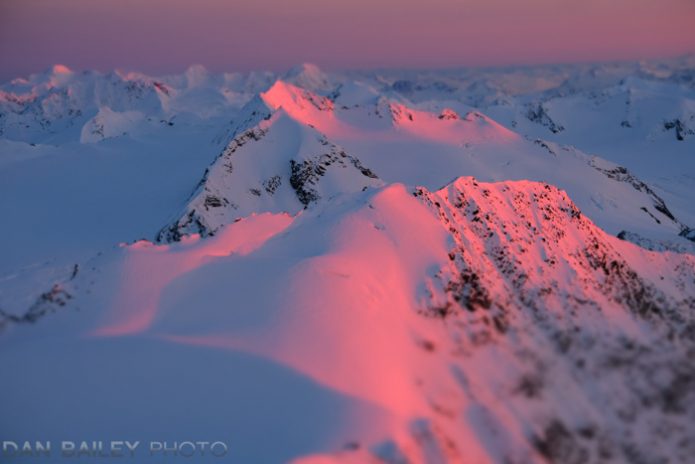
Many photographers know the term “Alpenglow” to be that magical reddish, pink light from the setting sun that’s visible on the high mountain peaks during those last few moments of the day. It’s the light we all live for. It’s the golden rainbow unicorn for people who like to shoot landscapes.
Originally derived from the German word Alpenglühen, to describe this special occurrence of light seen on the Alps, the term Alpenglow was brought into vogue by giants like Galen Rowell, who influenced an entire generation of outdoor photographers, myself included.
In Tyrolean legend, it’s said that King Laurin, ruler of the dwarves built a rose garden on the mountain entranceway to his underground fortress. During an event where he was scorned by not having been invited to the wedding of the beautiful princess Similde, Laurin cursed his Rose Garden, proclaiming that “Neither by day nor by night should anyone again glimpse this lovely sight.”
However, he forgot to specify that time day and night: Twilight, and so it is only during dawn and dusk when the wonderful pink glow of his rose garden can be seen on the sides of the mountains.
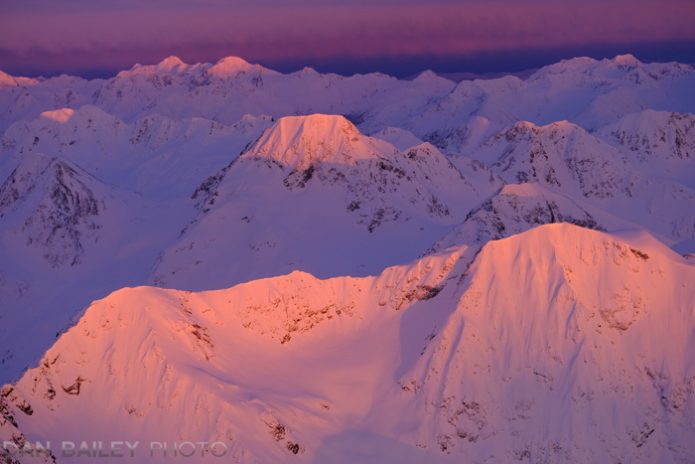
Dwarves and fairly tales aside, what exactly is Alpenglow? The current accepted definition of Alpenglow is that it’s an optical phenomenon that occurs as a reddish glow near the horizon, most visible on higher elevations and peaks opposite of the sun “when the sun is below the horizon.”
This theory says that after sunset, there is no more direct sunlight on the mountains, but the existing ambient, or indirect light is reflected and scattered off moisture, ice crystals and other airborne particles in the lower atmosphere, which causes that special pink and red glow on the mountains.
Thus, true Alpenglow is defined as a form of Indirect Light, and is different from the direct light we see just before sunset.
However, I’m not so sure that’s accurate

Download My Free Photography eBook
Let me show you some techniques that will help make you a better, more proficient and more creative photographer!
In fact, I will be so bold as to challenge the accepted definition and state that Alpenglow is actually caused by Direct Light.
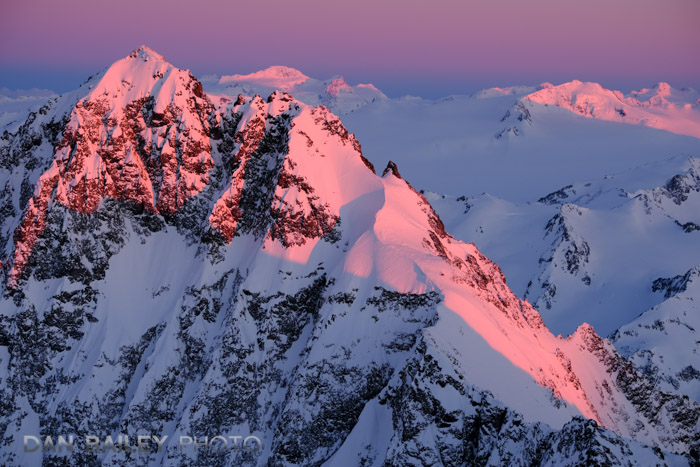
As you probably know, the warm, red, orange and yellow light of sunrise and sunset is caused by the longest wavelengths in the visible spectrum of electromagnetic energy. When the sun is low on the horizon, its light skims across the surface of the earth and passes through all the particles in our atmosphere.
The short blue waves of light are easy scattered by all those particles in the air, leaving only the longer red and orange light waves to make it all the way through to our eyes. This is the light we see at “Magic Hour,” and it’s the light we all crave as photographers. It’s the light that makes entire careers.
After sunset, the dim blue light of twilight, also know to photographers as “Blue Hour,” rises and pushes the band of pink higher into the sky. The defined blue line, which you can see in the two photos above, is actually the shadow of the earth, which rises as the sun dips below the horizon. That pink light above the line is actually the part of the sky still being hit by the direct sun, it’s just higher than anything on the planet.
Here’s Why I Think That Alpenglow is Caused By Direct Light
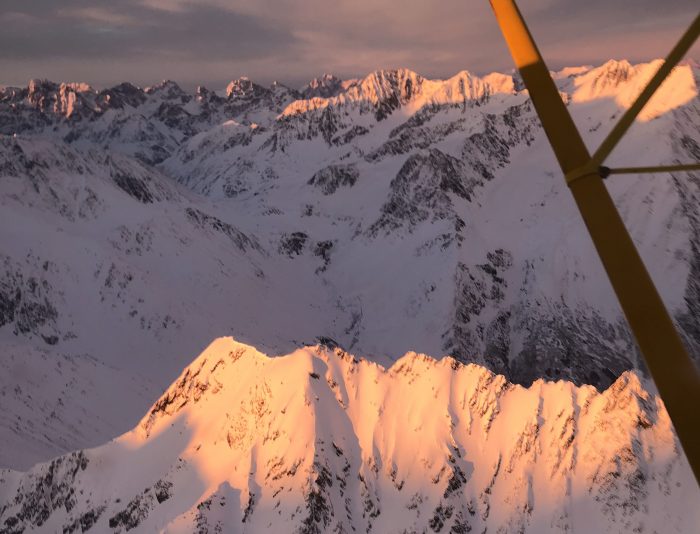
I have a secret weapon that I use to confirm my ideas on this matter: a 1947 Cessna 120, which I use to shoot aerials over the mountains at sunset. I often do my aerial photography in the winter and early spring, when the mountains are still covered in snow. This gives alpenglow and evening light the most pronounced look.
When I head up into the sky, I often fly around and photography mountains that can be seen from town. These are the same mountains I can see from my street.
Let’s say that on a given afternoon, my wife is standing on our front porch, looking at the mountains right after sunset, when the sun is no longer visible in the sky. She can see the brilliant pink light hitting the mountains of the Chugach Front Range. By definition, she is witnessing the stated phenomenon of Alpenglow.
If I’m in my little Cessna, flying around the mountains at the very same moment, I’m seeing that exact same pink light. It’s even more vivid and brilliant, because instead of being 10 miles away, I’m right up there next to the peaks.
But the thing is, I can still see the sun, because it still has not set for me. I’m seeing Direct Light on the peaks, which is creating that very same pink light my wife is witnessing on the ground.
How can this be?
It’s rather simple. The sun sets at different times at different altitudes. If I look at the sunset calculator, and plug in the Lat/long coordinates for Anchorage, Alaska, and enter the altitude for my street, about 39 meters, it shows a sunset time of 6:04pm.
If I then plug in for altitude of 2,133 meters, or 7,000 feet for the same location, which equates to my vantage point the plane when when I shot this picture below of Eagle Peak and Organ Mountain, it shows a sunset time of 6:11pm; a seven minute difference.
Given the position of light on these mountains, it still be another 5 or so minutes until the sun has official set on the summits of these peaks.

This means, my wife, who is watching from our porch, will see the Indirect Light of Alpenglow for about 10 minutes after the sun has set from her perspective, while at the very same time, I am witnessing the exact same illumination as Direct Light.
In addition, from my experience shooting sunset aerials, as soon as the sun disappears from my view, the pink light is gone. Even though the light is often the most brilliant during those last few moments of sunset, as soon as it dips below the horizon, that gorgeous light fades and
So, my hypothesis is that it’s a matter of perspective. Just because you can’t see the sun from your position on the ground, doesn’t mean it’s not still shining directly on the higher elevations.
In my mind, this debunks the traditionally accepted definition of Alpenglow as being a form of indirect light, because most people who see it are standing on the ground.
Here is a series of photos to support my hypothesis:
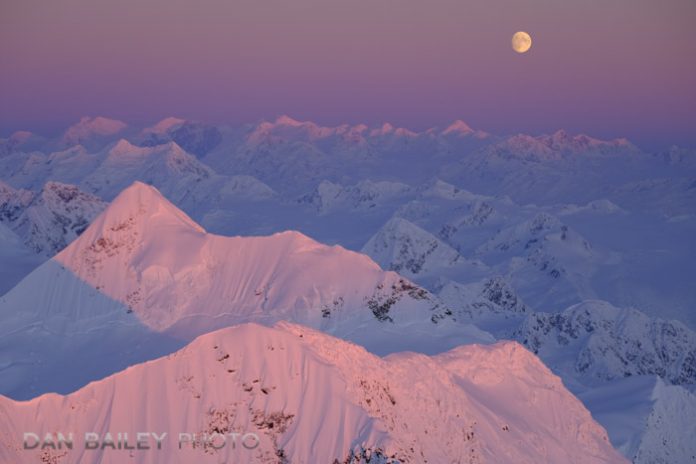
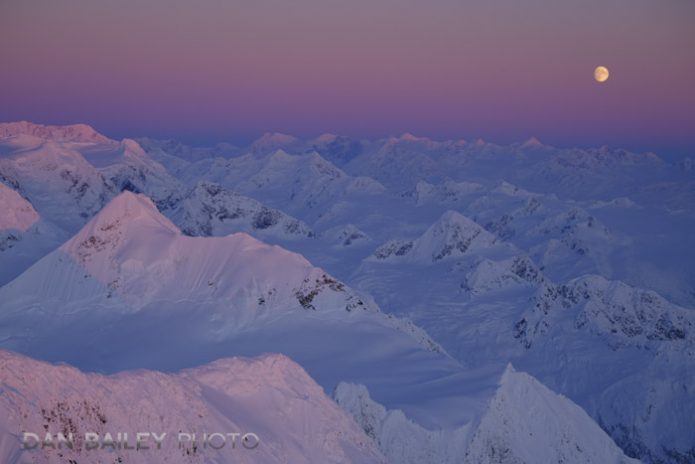
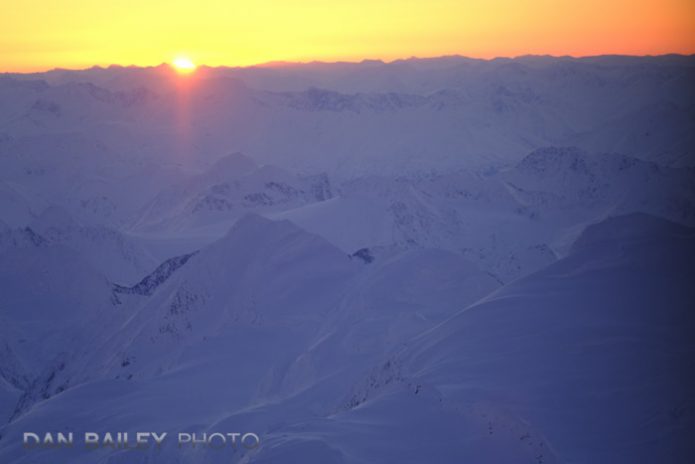
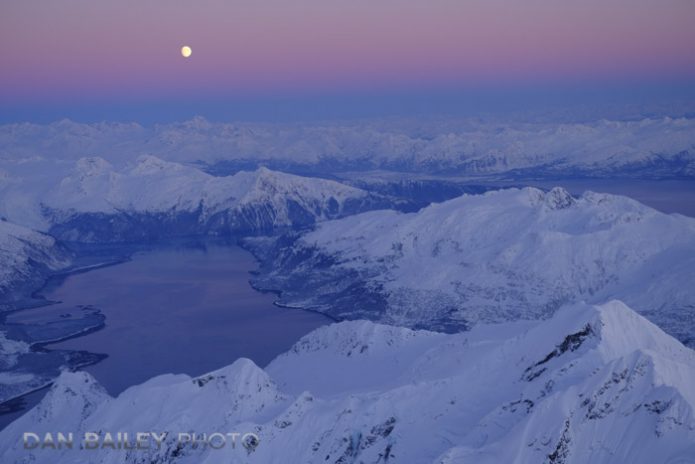
I’m not the only person who thinks this way. Gary Crabbe, who worked with Galen Rowell for seven years, also shares my hypothesis that Alpenglow is indeed a form of Direct Light. Also, on the Talk:Alpenglow page on Wikipedia, one person argues this fact:
“To say that Alpenglow occurs after the sun goes down is like stating that you can break up a ray of light using a prism, without shining the ray of light.”
On the same page, another user references this picture of Mote Viso, by Stefano De Rosa as proof that alpenglow occurs without direct light, stating that there are no shadows present, which indicates that this is indirect light.
However, if you look closely at the picture, you can indeed see defined shadows on the upper ridges from light that’s coming in from the left. They’re faint, but that’s because they’re being viewed through 40+ miles of air and haze.
Also, while the Basilica of Suerga in the photo sits at a mere 672 meters in elevation, the entire east wall of 12,602 foot high Monte Viso sits well above the 2,700 meter mark, which means that the entire east face of the peak could be hit by direct sunlight well before the light finally touches the basilica.
And, in nearly every example picture I see of “Alpenglow” around the web, you can see a defined line between light and shadow. If there’s shadow present, then you’re looking at direct light.
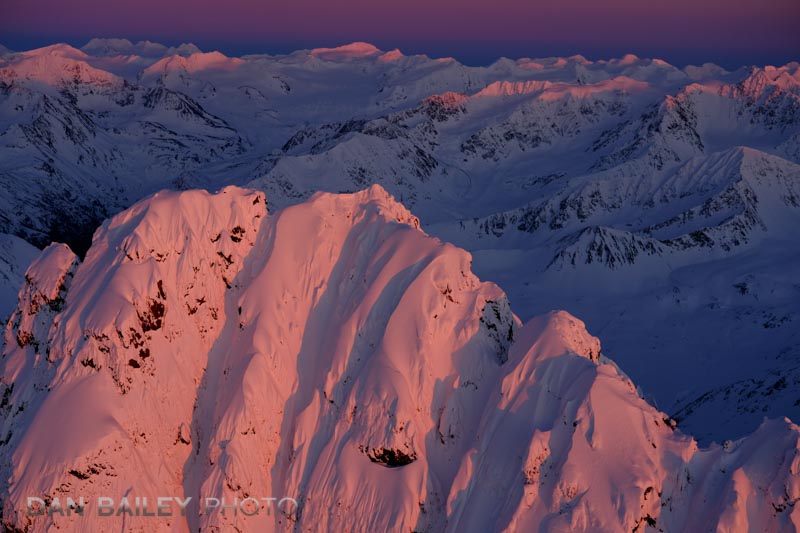
My aerial photography has prompted me to pondering this notion for awhile now, and while searching the web the other day, I came across this alpenglow post on Photo.net, where Gary insists that if you stood on a ladder high enough to be at the same level of the peaks, you would indeed see the sun.
This is further confirmed by the fact that long after sunset, we can still see vivid color in the clouds. Again, if you were on a ladder at the same height as the clouds, you would see the sun. Again, Direct Light.
Although no one actually has a ladder that tall, an airplane serves the same purpose. Gary, who has a keen interest in astronomy, also states that it would take a much greater mass than the earth to warp gravitational space enough to bend lightwaves.
If this is indeed true, (If only we had time to ask Stephen Hawking his opinion on the matter. R.I.P, Dr. Hawking), then what we consider to be the traditionally accepted cause of alpenglow would therefore be impossible.
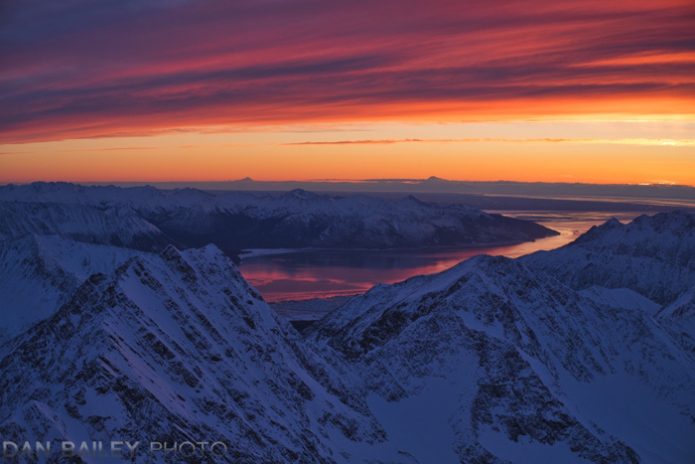
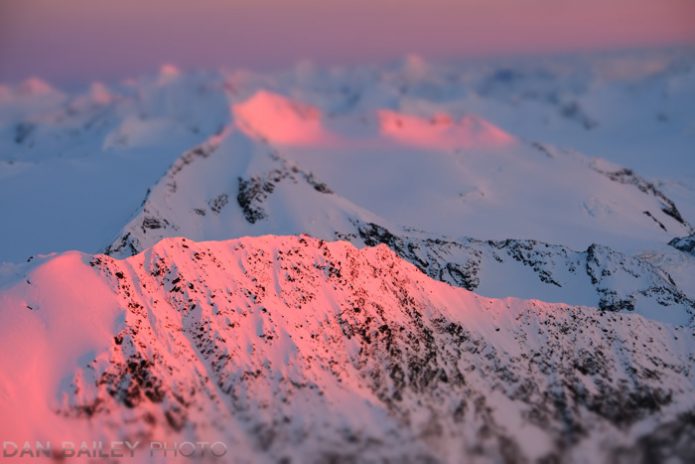
Should You Be Concerned by Any of This?
Of course not. Whether Alpenglow is accurately defined as Direct or Indirect light has absolutely no bearing on the wonderfully magical experience of shooting at sunrise and sunset. It has no effect on your ability to create stunning images of the landscapes during those special moments when the sun hovers at the edge of the horizon.
It doesn’t challenge the accepted notion that these can be the very best times to make photographs, or even just to stand there outside in awe at the natural world, whether you have a camera in your hands or not. Either way, I’m pretty certain that getting up early or staying outside late enough to witness this beautiful light will have a positive effect on your photography, as well as your general well being and overall outlook on the world.
This hypothesis, and the ideas that Gary and I put forward, are the stuff of science, semantics and philosophy. They’re the musing of curious minds, and, of course, a blatant excuse for me to show off my pretty pink mountain pictures.
So, what do you think? I’d love to hear your opinion on this, since I’m effectively debunking a longstanding definition about a very closely held topic for outdoor photographers everywhere. I certainly welcome healthy debate on the subject.
However, as Peter West Carey says is in alpenglow post on Digital Photography School, getting too much in a tizzy about the correct labeling of direct and indirect sunlight means you should probably step away from the computer and go should some photos. I take that as very good advice!
Let me know your thoughts.
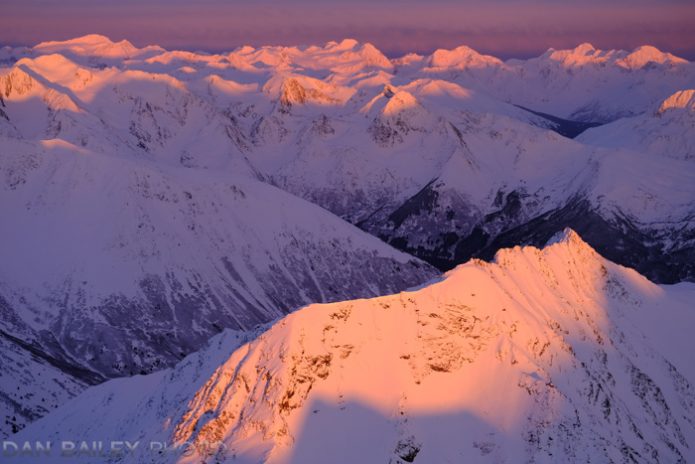


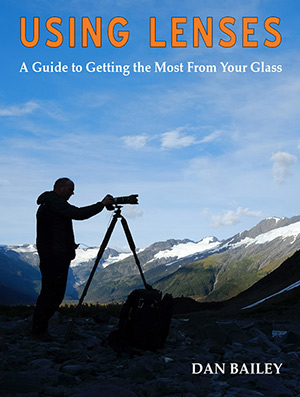

Hi Dan,
More or less I’m in agreement with your point. To me it seems that the Alpenglow is (indeed direct light but intertwined with the “nautical point of visibility” [ a nautical formula which connect height of you and height of the observed object]) I don’t have any particular formula on hand since I use to calculate approximately based on the size of my hand.
Hi Fulvio. Your point seems correct as well. It’s all about perspective. What is considered indirect light for one person is direct light for someone else who has a different point of observation. If I’m hiding behind a tree and shining a flashlight on an object in front of you, you can still see the direct light, even if you can’t see the actual source.
Nice article, even nicer pictures 🙂
From my point of view it’s self-evident that the peaks of mountains are still in direct sunlight when for us in the valley /further down the sun has already set.
Doesn’t just simple reasoning point to the rose color being the same reddish light we see at sunset?
Anyway – enjoyed your article. Thank you, Dan.
Hi Jen, thanks for your comment.
Yes, it’s a simple matter of perspective. It’s the very same light, just observed from different vantage points. Imagine if I were standing behind a tree, shining a flashlight on the person in front of you. Even though you can’t see me or my flashlight, you can still see the direct light hitting your friend. You’d be surprised at how often “simple reasoning” isn’t taken into account with certain observations. Then again, maybe not!
At any rate, I hope you get out and watch the wonderful rosy glows of sunset as often as you can!
I realize this is old, but after living in and photographing mountains for the last fifty years I felt compelled to comment. there seems to be a lack of understanding here regarding the sun and the horizon. Alpenglow when defined as “the result of indirect light on the peaks” has to do with AFTER the direct sun light has left the mountains. It has nothing to do with when the sun drops behind the horizon from the viewers perspective. While the setting sun will indeed bath the peaks in a warm hue, the afterglow that occurs AFTER the sun has left the peaks is an entirely different phenomena. What one wishes to call alpenglow is certainly their own decision, but the affect of setting sun light and post set light are entirely different.
John, thanks so much for your comment here. (I only just saw it ) I wrote this awhile ago, but having give this more thought, I would agree with the notion that “true” alpenglow is indeed the product of indirect light reflecting off the peaks, after passing through moisture and dust particles in the air after direct light has left the mountains. The perspective thing is a different issue, but I think that there are times when people mistake this direct light, even though the sun is no longer visible from their viewing position, as indirect light, and therefore call it alpenglow.
Perfect, yes. I have watched the direct light of a sunset on a mountain, as the shadows creep from below, up higher and higher. Once the last direct rays of light have left the peak, there is sometimes, in certain conditions, a rose color on the mountain for a very short time (maybe only 30 seconds), and then it all turns to black and white. I believe that rose color is Alpenglow.
excellent write up! i experience the joy of alpenglow from the valley floors in southern california and have always hypothesized similarly to you. cheers.
Thanks for your comment! Even when I’m not out flying or hiking, I’m still able to see and enjoy the sunset light and alpenglow over the Chugach Mountains right from my house!